Smartwatches are becoming increasingly popular as more and more people are becoming health-conscious. The Apple Watch 6 and the Fitbit Sense, the flagship models from reputable companies that were released around the same time, are two of the top smartwatch choices nowadays. But which one of them is more worth your money? In this Fitbit Sense vs Apple Watch 6 review, we give you a side-by-side comparison of how much these leading smartwatches are, their features, design, and a whole lot more to find out which one comes out on top.
Also read: Apple Watch Series 5 vs 6: Is It Worth The Upgrade?
Inside This Article
- Fitbit Sense vs Apple Watch 6: At a Glance
- What You Should Know About the Fitbit Sense
- What You Should Know About the Apple Watch 6
- Fitbit Sense and Apple Watch 6 Compared
- Fitbit Sense vs Apple Watch 6: The Better Smartwatch
Fitbit Sense vs Apple Watch 6: At a Glance
| Features | Fitbit Sense | Apple Watch 6 |
|---|---|---|
| Market Launch Price | $329 | $399 |
| Release Date | September 25, 2020 | September 18, 2020 |
| Weight | 45.9 grams with the small band; 48.2 grams with the large band | 30.5 grams to 41.3 grams (depends on the size and finish) |
| Dimension | 40.48 mm x 40.48 mm x 12.35 mm | 40 mm: 40 mm x 37 mm x 10.7 mm
44m: 44 mm x 37 mm x 10.7 mm |
| OS | Fitbit OS | watchOS 7 |
| Compatibility | Android and iOS | iOS only |
| Up to 6 days | 18 hours | |
| Link to Store | Go to site | Go to site |
What You Should Know About Fitbit Sense
Adore
- Battery can last up to six days
- Fast charging
- Less expensive
- Includes EDA sensor for stress management
- Offers incredibly detailed sleep tracking data
- Lots of options for watch faces, including those from third-party developers
Against
- Noticeable lag when opening apps
- Heart rate tracker takes a while to catch up with your workout
- Fitbit Premium subscription is required to get a detailed analysis of your health stats
The Fitbit Sense is Fitbit’s latest smartwatch, and it’s definitely the brand’s most ambitious one yet. Its features focus mostly on health and fitness tracking, with advanced sleep tracking, SpO2 (or blood oxygen) monitoring, the added electrodermal activity (EDA) sensor for stress management, and many more. It also boasts an incredibly long-lasting battery life as well of up to six days, so you wouldn’t need to constantly charge with this one. Plus, Fitbit Sense has the advantage of being compatible with both Android and iOS devices.
That said, Fitbit Sense has its own drawbacks as well. For one, it only offers 4 GB of total storage, but you can only really use 2.5 GB. Users might also notice that its response tends to be a bit laggy, especially when opening and syncing apps. To make it worse, you’ll need a Fitbit Premium subscription worth $9.99 a month if you want to get detailed analyses of your sleep quality, EDA readings, and other stats.
What You Should Know About Apple Watch 6
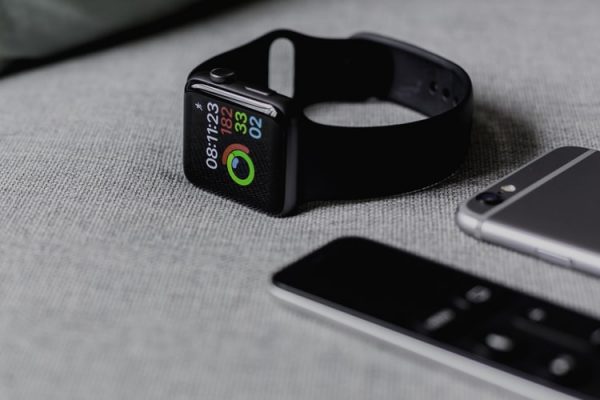
Adore
- Includes 32 GB of total storage
- Clear, bright display even in broad daylight
- Easy to navigate
- Includes noise and fall detection
- Offers a built-in LTE option
Against
- Pricier than most smartwatches
- Not compatible with Android devices
- No third-party watch face options at the moment
Apple packs in features beyond health tracking with their most recent smartwatch offering. It has an electrocardiogram (ECG) app, sleep tracker, blood oxygen monitor, and all the fitness features you can hope for in a smartwatch. Plus, it has a built-in LTE option, so you can take and make calls, send text messages, and connect to the Internet even when you don’t have your phone with you. There’s also a noticeable improvement in the display’s maximum brightness, making it easier to see even in broad daylight.
But just like the Fitbit Sense, the Apple Watch 6 has certain disadvantages that you should also take note of. First, there’s the issue of compatibility. You can only really use the Apple Watch 6 if you’re an iOS user, which won’t come as a shock to anyone. At $399, it’s also among the priciest smartwatches in the market, and it costs at least $100 more if you want built-in LTE.
Also read: Apple Watch GPS vs Cellular
Fitbit Sense and Apple Watch 6 Compared

At first glance, the Fitbit Sense and the Apple Watch 6 don’t seem that different from one another. They have a handful of things in common, apart from having similar designs. They both track specific aspects of your health and fitness, let you send text messages, and are waterproof, just to name a few. However, there are several significant differences between the two, which we’ll look into in this Fitbit Sense vs Apple Watch 6 comparison.
Fitbit Sense vs Apple Watch 6: Design and Form Factor
First impressions matter, which is why design and form factors are two important considerations when buying a smartwatch. Here’s an analysis of how Fitbit Sense and Apple Watch compare on this aspect.
Fitbit Sense

The Fitbit Sense features a classier and slicker look than the Versa 2, which was released a year prior. It comes in three colors: Silver, Graphite, and Soft Gold. One noticeable change is the lack of a physical button; in its place is a small indentation for a haptic sensor that lets you navigate the screen, launch apps, and wake your smart assistant. However, controlling your smartwatch with it does take a bit of getting used to.
The Fitbit Sense also veers from the earlier Fitbit smartwatches by having a medical-grade stainless steel rim instead of the usual aluminum, making it resistant to corrosion. Plus, it’s a bit thicker because of all the added sensors inside. It has a color screen with an always-on display, which you can disable anytime to preserve battery life. There’s also a wide range of first- and third-party watch faces to choose from, so switching up your Fitbit Sense’s look won’t be a problem.
Thankfully, Fitbit has retired the old pins and levers that users had to wrestle with just to change the straps. Now, there are quick-release buttons underneath, making the process a lot easier. Also, you can pair the watch itself with a variety of Fitbit Sense bands. The silicone Infinity Band that it comes with tends to fall off your wrist, though. Thus, it’s best to get an accessory band that has a more secure buckle, especially if you’re going to use your Fitbit Sense during workouts.
Also read: 10 Best Fitbit Replacement Bands Available Today
Apple Watch 6
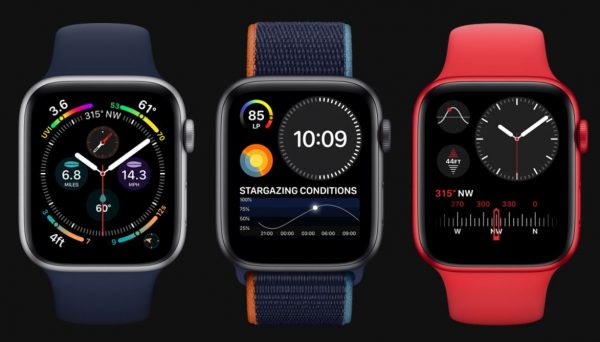
In terms of design, the Apple Watch 6 isn’t all that different from the ones that came before it. It still has a long-ish square watch face that comes in two sizes — 40 mm and 44 mm. It also still features a side button and a digital crown for easy navigation. The bezels surrounding the screen are slim, so it doesn’t take away much from the screen size.
The Apple Watch 6 is available in three different finishes: aluminum, stainless steel, and titanium. There’s a considerable price difference depending on which one you pick, with aluminum being the cheapest (and also the cheapest-looking) and titanium being the priciest. Besides the price, they also differ in terms of weight; the aluminum Apple Watch 6 is the best pick if you’re looking for something lightweight since it only weighs around 30 grams. The titanium and the stainless steel ones are heavier, but not by a lot. Respectively, they each weigh around 35 grams and 40 grams.
Just like the Fitbit Sense, the Apple Watch 6 has an always-on, color screen. You can also change up the watch face from the Apple Watch app. However, you’ll find considerably fewer watch face options for Apple Watches as they don’t offer third-party designs, unlike Fitbit Sense. You can also change up your Apple Watch 6’s look with an assortment of bands that come in different designs and materials.
Also read: 15 Best Apple Watch Bands and Straps of 2020
Chipset and OS

A smartwatch’s chipset and OS are essentially its lifelines, and these determine what it’s capable of. In this section of our Fitbit Sense vs Apple Watch 6 review, we’ll find out whether these smartwatches’ differences in terms of chipset and OS give either of them an advantage.
Fitbit Sense
The Fitbit Sense runs on the company’s proprietary OS, Fitbit OS, and boasts a faster processor than previous Fitbit watches. Its responses are noticeably quicker when compared to the Versa 2, but it still isn’t as snappy as you’d hope it to be. There’s an occasional lag when you swipe on the screen and apps don’t open immediately when you tap on them. It also takes a while for the screen to turn on when you raise it. Similar to previous Fitbit watches, transferring new watch faces from the mobile app to Fitbit Sense takes around 30 seconds.
The Fitbit Sense also doesn’t offer much when it comes to internal storage. Of the total 4 GB memory, only 2.5 GB is usable. So, although it can host third-party apps and store music, it won’t be able to hold that many.
Apple Watch 6
On the other hand, the Apple Watch 6 uses watchOS 7, the latest in the series. With it comes new watch face options (although still not as many as Fitbit Sense’s) and new fitness and smart features.
The Apple Watch 6 runs on an Apple S6 system-in-package (SiP), an upgraded dual-core processor that the company claims can perform up to 20% faster than the chip in the Apple Watch 5 and the Apple Watch SE. It also features an Apple U1 chip and ultra-wideband (UWB) antennas, which allow for more precise location tracking.
You get more storage space with the Apple Watch 6 as well. It offers a total of 32 GB of internal memory, but only 26.6 GB is available to you. Still, that’s enough to store a considerable number of songs, podcasts, and third-party apps.
Fitbit Sense vs Apple Watch 6: Fitness Tracking
Fitness tracking is probably the primary reason why you’re looking to buy either a Fitbit Sense or an Apple Watch 6. And while both smartwatches offer advanced features for monitoring your health and wellness, it’s important to note that the only medically-certified sensor on the Fitbit Sense and the Apple Watch 6 is the ECG reader, which is FDA-cleared for both smartwatches. Thus, you shouldn’t rely solely on the data they give you to monitor your health. It’s still best to seek medical advice from a professional.
Now, let’s take a look at how the Fitbit Sense and the Apple Watch 6 help you keep track of your health and wellness.
Fitbit Sense
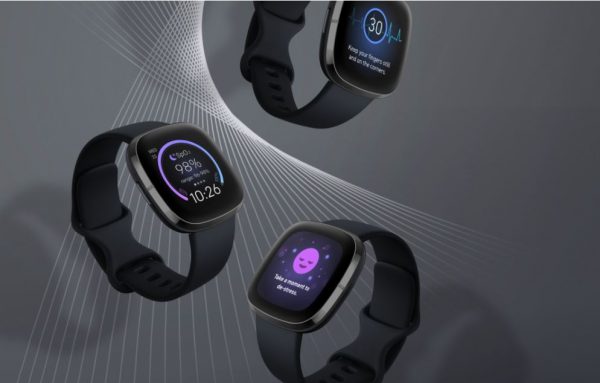
One of the things that make the Fitbit Sense different from the Apple Watch 6 is that it has an EDA sensor. This detects minute changes in sweat secretion, which can be an indication of your stress levels. You can log how calm or stressed you are after an EDA scan so that you can have a better idea of what your stressors are.
The Fitbit Sense also gives you a Stress Management Score on a scale of 1 to 100 based on your EDA scans, heart rate, activity level, and sleep level. However, the way it presents your score is a bit confusing with the higher number indicating that you’re less stressed.
Another stand-out fitness feature of Sense is the skin temperature sensor. The first of its kind, it takes note of your baseline temperature and monitors significant deviations from your normal range.
On top of that, the Fitbit Sense comes with an FDA-cleared ECG app to help you detect heart rhythm irregularities. It also monitors menstrual cycles, your SpO2 level, heart rate changes, and your breathing rate. This smartwatch is a handy companion for workouts as well, thanks to its Workout Intensity Map, heart rate zone indicator, and over 20 goal-based exercise modes. However, its heart rate tracker tends to be laggy, so it won’t show you an accurate BPM reading until about ten minutes into your workout. It does catch up eventually, but it’s still something to consider before buying a Fitbit Sense.
The Fitbit Sense is water-resistant up to 50 meters, so you can wear it while swimming or taking a shower. It comes with a six-month free trial of the Fitbit Premium app, which gives you extremely detailed but easy-to-understand data about your overall health. After the trial, it’ll cost $9.99 a month.
Apple Watch 6

Although the Apple Watch 6 doesn’t have the EDA and skin temperature sensors that Fitbit Sense has, it’s still a reliable fitness partner. For starters, it has a SpO2 reader that can monitor your blood oxygen levels in three ways: through on-demand spot readings, in the background throughout the day, and while you’re sleeping. The Fitbit Sense, on the other hand, can only monitor your SpO2 while you’re asleep and within the first hour of the day. It also has an FDA-cleared ECG app just like the Fitbit Sense.
The Apple Watch 6 also tracks low-range VO2 max, which measures the highest amount of oxygen your body consumes during a workout. This helps you see whether your heart and lungs are working normally when you exercise. It can also track over 40 exercise types, including walking, core training, yoga, and rowing. Plus, it’s great for those who use a manual wheelchair. But if you can’t find a particular workout type, you can easily add it to the Apple Watch 6’s Workout app.
Unlike with the Fitbit Sense, you can store music and podcasts in your Apple Watch 6 so that you can have something to keep you pumped throughout a workout. It also has an always-on altimeter that monitors real-time elevation changes. To help you keep track of your goals for the day, the Apple Watch 6 shows you three Activity Rings, which each indicates the calories you’ve burned, how much brisk activity you’ve done, and how many times you’ve moved around in the past hour.
Apart from those, the Apple Watch 6 also lets you share your activity stats and compete with friends in seven-day challenges. And similar to the Fitbit Sense, it’s water-resistant up to 50 meters.
Fitbit Sense vs Apple Watch 6: Connectivity and Communications

Both the Fitbit Sense and the Apple Watch 6 have Bluetooth connectivity as well as a loudspeaker and a mic. They both also let you send text messages and emails, make calls, adjust volume, and receive app notifications. With Fitbit Sense, you can send quick replies and voice replies. However, you can only reply to messages through your Fitbit Sense if you’ve paired it with an Android phone. Note as well that your phone has to be nearby. If you’re using your Fitbit Sense with an iPhone, you can only see text and app notifications, but you’ll have to use your phone to respond to any of them.
The Apple Watch 6, on the other hand, has more to offer in terms of connectivity and communication. Other than voice and quick replies, the Apple Watch 6 also lets you send emojis, animojis, and Scribble replies. Plus, it offers a built-in LTE option, although at a much higher price. With built-in LTE, you can send texts, respond to app notifications, make calls, and stream music even if you don’t have your phone with you.
Battery and Charging
Battery life is another important factor when shopping for a smartwatch. After all, who would want to be constantly charging their devices? Let’s take a look at how Fitbit Sense fares with the Apple Watch 6 in terms of battery life.
Fitbit Sense
Right off the bat, the Fitbit Sense is pretty impressive for its long battery life. It can last up to six days, as long as you disable the always-on display feature and don’t always turn on GPS tracking. If you enable the always-on display feature and GPS tracking, it can last up to two days, which is still pretty good. Of course, its battery life will still depend on your usage. To check how much battery charge is left on your Fitbit Sense, you can swipe right on the watch face or check the Fitbit app.
Fitbit also upgraded the charging method for Sense. Its charger is less chunky as compared to that of the Versa 2, and it now magnetically connects to the back of the watch. Charging the Fitbit Sense to 100% takes around an hour and a half to two hours. However, if you’re in a hurry, you can just charge it for 12 minutes, which will give you a full day of battery life.
Apple Watch 6
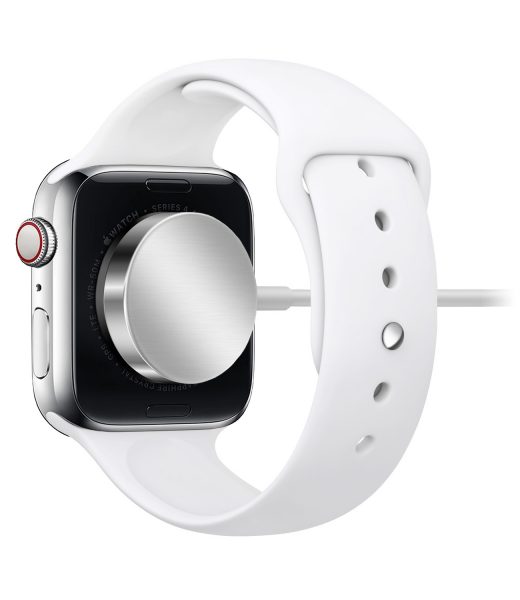
The Apple Watch 6’s battery life isn’t as extensive as the Fitbit Sense’s, and you will have to charge every single day with this one. It only offers 18 hours of battery life with typical use, which is on the lower end of the spectrum considering other smartwatches that can last up to a full week or, in the case of watches like the Honor MagicWatch 2, even two weeks. However, you can extend the battery life to a day and a half if you disable the always-on display feature. Take note as well that you need at least a 30% battery charge if you plan to use the Apple Watch 6’s sleep tracking feature.
Unlike Fitbit, Apple Watch chargers are backward-compatible, meaning you can use the charger of an earlier Apple Watch to charge the Apple Watch 6. Like the Fitbit Sense, the Apple Watch 6 uses a magnetic charger. It also takes around an hour and a half to charge fully, a slight improvement from the Apple Watch 5, which requires two hours to top up.
Fitbit Sense vs Apple Watch 6: Additional Smart Features
Both the Fitbit Sense and the Apple Watch 6 boast smart features beyond fitness tracking and communication, which are all summarized in this handy chart:
| Features | Fitbit Sense | Apple Watch 6 |
|---|---|---|
| Voice Assistant | Amazon Alexa and Google Assistant | Siri |
| Sleep Tracking | Yes | Yes |
| Smart Wake | Yes | No |
| GPS | Yes | Yes |
| Mobile Payment | Fitbit Pay | Apple Pay |
| Fall Detection | No | Yes |
| Noise Detection | No | Yes |
| Hand-washing Monitor | No | Yes |
Now, let’s take a more in-depth look at how these additional smart features work in the Fitbit Sense and the Apple Watch 6.
Fitbit Sense
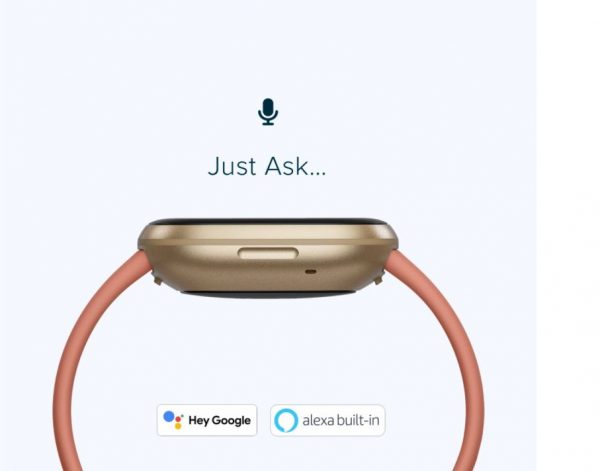
The Fitbit Sense has support for two voice assistants: Alexa Built-in and Google Assistant, which was added only recently. With these virtual assistants, you can start a workout, control your smart devices at home, check the weather, as well as set alarms and reminders. Plus, you’ll get audio responses through Fitbit Sense’s speaker.
The Fitbit Sense offers advanced sleep tracking as well. Not only does it record the duration of your sleep, but it also gives you daily sleep scores, so you get an insight into your sleep quality every night. It notes your heart rate variability while you sleep, your sleep stages, restlessness, and other useful stats. However, this only comes with a monthly Fitbit Premium subscription. The Fitbit Sense also has a Smart Wake feature that sets off during the light sleep stage, so you don’t wake up groggy. Unlike traditional alarms, the Smart Wake feature wakes you up with a light, almost inaudible buzz on your wrist. This is useful if you sleep in a room with another person.
There’s also a built-in GPS, so you can track your pace and distance when you work out outdoors. With Fitbit Sense, you can also make contactless payments using Fitbit Pay.
Apple Watch 6
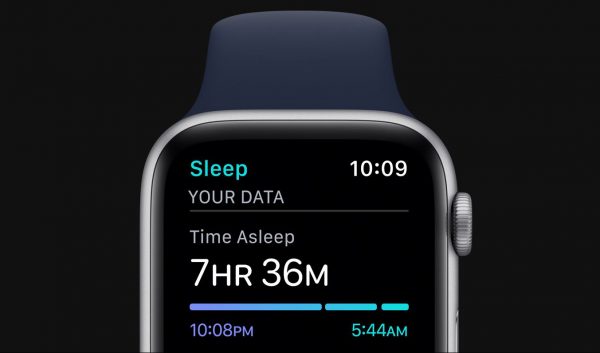
The Apple Watch 6 comes with Siri, and unlike with previous Apple Watches, you don’t have to press the Digital Crown on the side to summon her; simply say “Hey Siri,” and you’ll be able to set timers, start workouts, get directions, and more without moving a finger.
It offers sleep tracking as well, but it isn’t as robust as Fitbit Sense’s since it mostly focuses on the duration of your sleep. And as we mentioned earlier, you need at least a 30% battery charge left on your Apple Watch 6 to track your sleep.
The Apple Watch 6 also has GPS tracking and lets you pay on the go with Apple Pay. It also offers three unique smart features: a handwashing monitor, noise detection, and fall detection. The handwashing monitor detects when you’re washing your hands using the mic and motion sensors. It then sets a timer for 20 seconds, which is the recommended handwashing duration of the CDC and WHO. If you stop washing your hands before the end of the countdown, the watch urges you to keep going. If you enable handwashing notifications, it also reminds you to wash your hands when you get home.
The noise detection feature monitors the ambient noise levels and the duration of your exposure to these noises. It alerts you with a tap on your wrist if the noise reaches a level that can damage your hearing. There’s also a fall detection feature, which is especially helpful for seniors. It can detect when you’ve had a hard fall and taps you on the wrist if you remain immobile after about a minute. It also plays an alert to notify those nearby. If you’re still motionless after 30 seconds, the watch automatically calls emergency services.
Fitbit Sense vs Apple Watch 6: Verdict
Both the Fitbit Sense and the Apple Watch 6 have a lot to offer in the realm of fitness and beyond, but they also have their own drawbacks. Thus, picking which of these leading smartwatches really is up to you. It all depends on which features you consider essential. If stress and temperature management, advanced sleep tracking, and long battery life matter to you, then you should probably go for the Fitbit Sense. However, you’ll also have to put up with occasional laggy responses and a slow-to-start heart rate monitor.
The Apple Watch 6 sounds like a good deal as well. It has all the fitness trackers you need in a smartwatch, a handy fall detection feature, and a built-in LTE connectivity option. Plus, it’s easy to navigate, and it performs significantly faster than Fitbit Sense. That said, it is much more expensive and requires constant recharging. And, unsurprisingly, it isn’t compatible with Android devices. But if those aren’t deal-breakers for you, then the Apple Watch 6 is the clear winner here.
